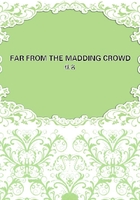If we have to say so much with regard to ancient demesne and bond socmen, we must not wonder that free socmen are very often placed in conditions which it would be impossible to reduce to a definite plan. On the fee of Robert le Noreys, in Fordham,(84*)we find some scattered free tenants burdened with entirely irregular rents, four villains holding eighteen acres each and subjected to heavy ploughing work, three socmen of twenty acres each paying a rent of 4s. 2d. per holding, and obliged to assist at reaping and to bring chicken, one socman of nine acres paying 10d., one of seven acres also assessed at 10d., two of eleven acres paying 15d., etc, it is no cause for wonder that such instances occur at the end of the thirteenth century. It is much more wonderful that, in a good many cases, we are still well able to perceive a great deal of the original regularity. Swaffham Prior, in Cambridgeshire, is a grand example of an absolutely regular arrangement in a community of free socmen.(85*) The Prior of Ely holds it for three hides and has 220 acres on his home-farm. The rest is divided among sixteen free socmen paying 5s. each and performing various labour services. These services have been considerably increased by the Prior. Mixed cases are much more usual -- I mean cases in which the original regularity has suffered some modifications, though a little attention will discover traces of the ancient communal arrangement.(86*)On the whole, I think that the notices of socmen's tenure in the Hundred Rolls are especially precious, because they prove that the observations that we have made as regards freehold generally are not merely ingenious suggestions about what may conceivably have happened. There is undoubtedly one weak point in those observations, which is due to the method which we are compelled to adopt. It is difficult, if not impossible, to classify the actual cases which come before us, to say-in this case freehold is the result of commutation, in that case the lord has enfeoffed a retainer or a kinsman, while in this third case, the freehold virgate has always been freehold. The edge of the inquiry is blunted, if I may so say, by the vagueness of terminological distinctions, and we must rely upon general impressions. The socman's tenure, on the contrary, stands out as a clear case, and a careful analysis of it abundantly verifies the conclusions to which we have previously come by a more circuitous route.
It seems to me that the general questions with which we started in our inquiry may now be approached with some confidence. The relation of free tenancies to the manorial system turns out to be a complex one. The great majority of such tenements appears as a later growth engrafted on the system when it was already in decay. Commutation of services, the spread of cultivation over the waste, and the surrender of portions of the demesne to the increasing dependent population, must largely account for the contrast between Domesday and the Hundred Rolls.
But an important residue remains, which must be explained on the assumption that in many cases the shares of the community were originally distributed among free people who had nothing or little to do with manorial work.
Three conclusions have been arrived at in this chapter.
1. The home-farm, though the necessary central unit of the manorial group, did not, as a rule, occupy a large area, and the break-up of feudalism tended to lessen its extension in favour of the dependent population.
2. The peculiar feature of medieval husbandry -- the grouping of small households round an aristocratic centre -- entailed the existence of a large class engaged in collecting revenue, superintending work, and generally conducting the machinery by which the tributary parts were joined with their centre.
3. The position of free tenements within the manor may be ascribed to one of three causes: (a) they have been the tenements of serfs, but, in consequence either of some general commutation or of special feoffments, they have become free; or (b) their connexion with the manor has all along been rather a matter of jurisdiction than a matter of proprietary right, that is to say, they form part of the manor chiefly because they are within the scope of the manorial court; or (c) they represent free shares in a village community upon which the manorial structure has been superimposed.
NOTES:
1. Bracton, iv. 9. 5, f. 263: 'Est autem dominicum quod quis habet ad mensam suam et proprie, sicut sunt Bordlands Anglice.'
2. Madox, History of the Exchequer, i. 407.., Concessisse unam virgatam terrae in Husfelds, scilicet 20 acras uno anno et 20acras alio.'
3. In Beauchamp, a manor of St. Paul's, London, the home farm is one of the largest. Domesday of St. Paul's, 28: 'In dominico tam de wainagio veteri quam de novo essarto 676 acre terre arabilis et de prato 18 acre et de pastura 8 acras [sic] et in magno bosco bene vestito quinquies 20 acre et in duabus granis Dorile et Langele 16 acras.'
4. As to the economic aspects of the subject, see Thorold Rogers, History of Agriculture and Prices; Ashley, Introduction to the Study of Economic History; and Cunningham, Growth of Industry and Commerce (2nd ed.).
5. Harl. MSS. 1006, f 2.
6. Ramsey Cart. (Rolls Series), i. 282: 'Quae culture coli possunt sufficienter cum tribus carucis propriis et consuetudine carrucarum ville et duabus precariis carucis (corr. carucarum?), quae consuetudo ad valentiam trium carucarum aestimatur.'
Domesday of St. Paul's, 13, 14: 'Potest ibidem fieri wainagium cum 5 carucis quarum tres habent 4 boves et 4 equos et due singule 6 equos cum consuetudinibus villate propter (corr.
praeter?) dominicum de Luffehale et alia quae remota sunt, que tamen sunt in dispositione firmarii.' Cf Glastonbury Inqu. of 1189, pp. 28, 107.
7. As an instance, Bury St. Edmund's Register, Harl. MSS. 743, f 194: '(Bucham) abbas Sti Edmundi capitalis dominus... tenet in eadem villa preter homagium liberorum nihil.'















